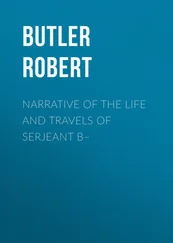Robert Vane Russell - The Tribes and Castes of the Central Provinces of India, Volume 4
Здесь есть возможность читать онлайн «Robert Vane Russell - The Tribes and Castes of the Central Provinces of India, Volume 4» — ознакомительный отрывок электронной книги совершенно бесплатно, а после прочтения отрывка купить полную версию. В некоторых случаях можно слушать аудио, скачать через торрент в формате fb2 и присутствует краткое содержание. Жанр: foreign_prose, История, foreign_edu, foreign_antique, на английском языке. Описание произведения, (предисловие) а так же отзывы посетителей доступны на портале библиотеки ЛибКат.
- Название:The Tribes and Castes of the Central Provinces of India, Volume 4
- Автор:
- Жанр:
- Год:неизвестен
- ISBN:нет данных
- Рейтинг книги:4 / 5. Голосов: 1
-
Избранное:Добавить в избранное
- Отзывы:
-
Ваша оценка:
- 80
- 1
- 2
- 3
- 4
- 5
The Tribes and Castes of the Central Provinces of India, Volume 4: краткое содержание, описание и аннотация
Предлагаем к чтению аннотацию, описание, краткое содержание или предисловие (зависит от того, что написал сам автор книги «The Tribes and Castes of the Central Provinces of India, Volume 4»). Если вы не нашли необходимую информацию о книге — напишите в комментариях, мы постараемся отыскать её.
The Tribes and Castes of the Central Provinces of India, Volume 4 — читать онлайн ознакомительный отрывок
Ниже представлен текст книги, разбитый по страницам. Система сохранения места последней прочитанной страницы, позволяет с удобством читать онлайн бесплатно книгу «The Tribes and Castes of the Central Provinces of India, Volume 4», без необходимости каждый раз заново искать на чём Вы остановились. Поставьте закладку, и сможете в любой момент перейти на страницу, на которой закончили чтение.
Интервал:
Закладка:
Uttam kheti, madhyam bān,
Kanisht chākri, bhīk nidān,
or ‘Cultivation is the best calling, trade is respectable, service is menial, and begging is degraded.’
46. Occupation
The Kurmi is the typical cultivator. He loves his land, and to lose it is to break the mainspring of his life. His land gives him a freedom and independence of character which is not found among the English farm-labourers. He is industrious and plodding, and inured to hardship. In some Districts the excellent tilth of the Kurmi’s fields well portrays the result of his persevering labour, which he does not grudge to the land because it is his own. His wife is in no way behind him; the proverb says, “Good is the caste of the Kurmin; with a hoe in her hand she goes to the fields and works with her husband.” The Chandnāhu Kurmi women are said to be more enterprising than the men, keeping them up to their work, and managing the business of the farm as well as the household.
Appendix
List of Exogamous Clans
Sections of the Chandnāhu subcaste:

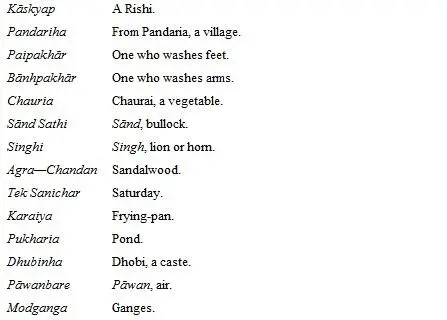
Sections of the Gabel subcaste:
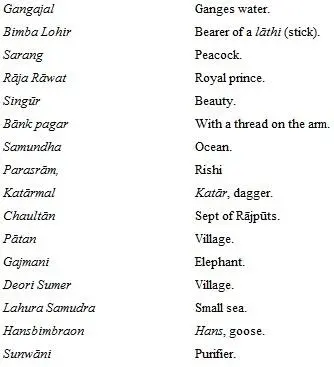
Sections of the Santora subcaste:
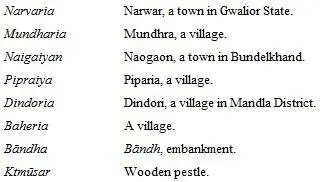
Sections of the Tirole subcaste:
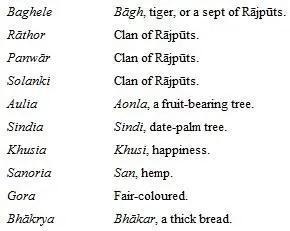
Sections of the Gaur subcaste:
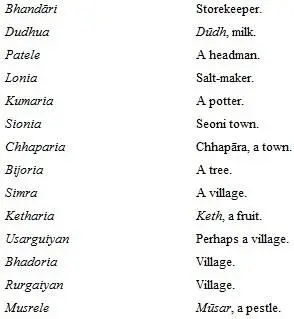
Sections of the Usrete subcaste:
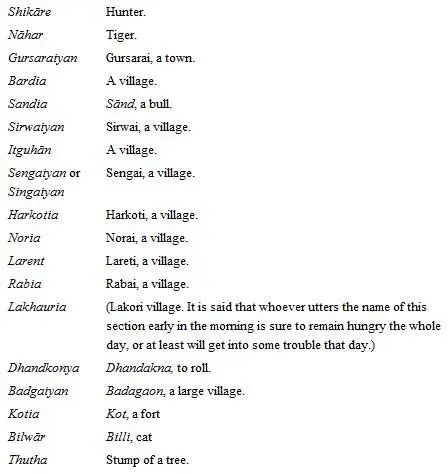
Sections of the Kanaujia subcaste:
• Tidha .—From Tidha, a village. This section is subdivided into ( a ) Ghureparke (of the cow-dung hill); ( b ) Dwārparke (of the door); and ( c ) Jangi (warrior).
• Chamania —From Chamyani (village). This is also subdivided into:
• ( a ) Gomarkya
• ( b ) Mathuria (Muttra town).
• Chaudhri (caste headman). This is divided as follows:
• ( a ) Majhgawān A village.
• ( b ) Purva thok Eastern group.
• ( c ) Pashchim thok Western group.
• ( d ) Bamurya A village.
• Rāwat Title.
• Malha Perhaps sailor or wrestler.
• Chiloliān Chiloli, a village.
• Dhanuiyan Dhanu Kheda, a village.
Lakhera
1. General notice
Lakhera, Laheri.—The small caste whose members make bangles and other articles of lac. About 3000 persons were shown as belonging to the caste in the Central Provinces in 1911, being most numerous in the Jubbulpore, Chhīndwāra and Betūl Districts. From Berār 150 persons were returned, chiefly from Amraoti. The name is derived from the Sanskrit laksha-kara , a worker in lac. The caste are a mixed functional group closely connected with the Kacheras and Patwas; no distinction being recognised between the Patwas and Lakheras in some localities of the Central Provinces. Mr. Baillie gives the following notice of them in the Census Report of the North-Western Provinces (1891): “The accounts given by members of the caste of their origin are very various and sometimes ingenious. One story is that like the Patwas, with whom they are connected, they were originally Kāyasths. According to another account they were made from the dirt washed from Pārvati before her marriage with Siva, being created by the god to make bangles for his wife, and hence called Deobansi. Again, it is stated, they were created by Krishna to make bangles for the Gopis or milkmaids. The most elaborate account is that they were originally Yāduvansi Rājpūts, who assisted the Kurus to make a fort of lac, in which the Pāndavas were to be treacherously burned. For this traitorous conduct they were degraded and compelled eternally to work in lac or glass.”
2. Social customs
The bulk of these artisan and manufacturing castes tell stories showing that their ancestors were Kāyasths and Rājpūts, but no importance can be attached to such legends, which are obviously manufactured by the family priests to minister to the harmless vanity of their clients. To support their claim the Lakheras have divided themselves like the Rājpūts into the Sūrajvansi and Somvansi subcastes or those who belong to the Solar and Lunar races. Other subdivisions are the Mārwāri or those coming from Mārwār in Rājpūtana, and the Tarkhera or makers of the large earrings which low-caste women wear. These consist of a circular piece of wood or fibre, nearly an inch across, which is worked through a large hole in the lobe of the ear. It is often the stalk of the ambāri fibre, and on the outer end is fixed a slab decorated with little pieces of glass. The exogamous sections of the Lakheras are generally named after animals, plants and natural objects, and indicate that the caste is recruited from the lower classes of the population. Their social customs resemble those of the middle and lower Hindustāni castes. Girls are married at an early age when the parents can afford the expense of the ceremony, but no penalty is incurred if the wedding is postponed for want of means. The remarriage of widows and divorce are permitted. They eat flesh, but not fowls or pork, and some of them drink liquor, while others abstain. Rājpūts and Banias will take water from them, but not Brāhmans. In Bombay, however, they are considered to rank above Kunbis.
3. The lac industry
The traditional occupation of the Lakheras is to make and sell bangles and other articles of lac. Lac is regarded with a certain degree of superstitious repugnance by the Hindus because of its red colour, resembling blood. On this account and also because of the sin committed in killing them, no Hindu caste will propagate the lac insect, and the calling is practised only by Gonds, Korkus and other primitive tribes. Even Gonds will often refuse employment in growing lac if they can make their living by cultivation. Various superstitions attach to the propagation of the insects to a fresh tree. This is done in Kunwār (September) and always by men, the insects being carried in a leaf-cup and placed on a branch of an uninfected tree, usually the kusum . 84 84 Schleichera trijuga .
It is said that the work should be done at night and the man should be naked when he places the insects on the tree. The tree is fenced round and nobody is allowed to touch it, as it is considered that the crop would thus be spoiled. If a woman has lost her husband and has to sow lac, she takes her son in her arms and places the cup containing the insects on his head; on arriving at the tree she manages to apply the insects by means of a stick, not touching the cup with her own hands. All this ritual attaches simply to the infection of the first tree, and afterwards in January or February the insects are propagated on to other trees without ceremony. The juice of onions is dropped on to them to make them healthy. The stick-lac is collected by the Gonds and Korkus and sold to the Lakheras; they clear it of wood as far as possible and then place the incrusted twigs and bark in long cotton bags and heat them before a fire, squeezing out the gum, which is spread out on flat plates so as to congeal into the shape of a pancake. This is again heated and mixed with white clay and forms the material for the bangles. They are coloured with chapra , the pure gum prepared like sealing-wax, which is mixed with vermilion, or arsenic and turmeric for a yellow colour. In some localities at least only the Lakheras and Patwas and no higher caste will sell articles made of lac.
Интервал:
Закладка:
Похожие книги на «The Tribes and Castes of the Central Provinces of India, Volume 4»
Представляем Вашему вниманию похожие книги на «The Tribes and Castes of the Central Provinces of India, Volume 4» списком для выбора. Мы отобрали схожую по названию и смыслу литературу в надежде предоставить читателям больше вариантов отыскать новые, интересные, ещё непрочитанные произведения.
Обсуждение, отзывы о книге «The Tribes and Castes of the Central Provinces of India, Volume 4» и просто собственные мнения читателей. Оставьте ваши комментарии, напишите, что Вы думаете о произведении, его смысле или главных героях. Укажите что конкретно понравилось, а что нет, и почему Вы так считаете.












